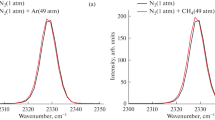Abstract
The use of optical diagnostic methods (spontaneous Raman scattering and coherent anti-Stokes light scattering) to measure gas impurity concentrations of less than 0. 1% is studied. The shapes of measured and calculated rotational Raman scattering spectra were compared to process experimental data. The technique was tested for measuring nitrogen, oxygen, and hydrogen concentrations in jets. Under the conditions of these experiments, changes in the ratio of oxygen and nitrogen concentrations during air diffusion into helium and hydrogen were not observed.
Similar content being viewed by others
References
B. V. Lukashov and S. V. Zhilivostova, “On the manifestation of multicomponent diffusion in a laminar boundary layer with impurity injection,” Teplofiz. A’eromekh., 15, No. 3, 505–511 (2008).
M. S. Makarov, “Numerical method for multicomponent diffusion with a posteriori evaluation of calculation accuracy on the basis of mass balance,” Int. J. Heat Mass Transfer, 52, Nos. 7/8, 1769–1773 (2009).
O. P. Korobeinichev, A. G. Tereshchenko, I. D. Emel’yanov, et al., “Substantiation of the probe mass-spectrometric method for studying the structure of flames with narrow combustion zones,” Combust., Expl., Shock Waves, 21, No. 5, 524–530 (1985).
J. C. Luthe, E. J. Beiting, and F. Y. Yueh, “Algorithms for calculating coherent anti-Stokes Raman spectra: Application to several small molecules,” Comput. Phys. Comm., 42, 73–92 (1986).
K. P. Huber and G. Herzberg, Molecular Spectra and Molecular Structure, Vol. 4: Constants of Diatomic Molecules, Reinhold, New York (1979).
A. Weber, “High resolution rotational Raman spectra of gases,” in: A. Weber (ed.), Raman Spectroscopy in Gases and Liquids, Springer-Verlag, New York-Belrin (1979).
H. Schretter and H. Klekner, “Raman scattering cross sections in gases and liquids,” in: A. Weber (ed.), Raman Spectroscopy in Gases and Liquids, Springer-Verlag, New York-Belrin (1979).
C. M. Penney, R. L. St. Peters, and M. Lapp, “Absolute rotational Raman cross sections for N2, O2, and CO2,” J. Opt. Soc. Amer., 64, No. 5, 712–716 (1974).
K. S. Jammu, G. E. St. John, and H. L. Welsh, “Pressure broadening of the rotational Raman lines of some simple gases,” Canad. J. Phys., 44, 797–814 (1966).
B. F. Boyarshinov and S. Y. Fedorov, “Measuring parameters of rotational gas flow by the coherent anti-Stokes light scattering method,” Prib. Tekh. Éksp., No. 6, 95–99 (1999).
Author information
Authors and Affiliations
Corresponding author
Additional information
Translated from Prikladnaya Mekhanika i Tekhnicheskaya Fizika, Vol. 51, No. 5, pp. 177–186, September–October, 2010
Rights and permissions
About this article
Cite this article
Boyarshinov, B.F., Fedorov, S.Y. Using Rotational Raman Scattering to Study Gas Impurities. J Appl Mech Tech Phy 51, 769–775 (2010). https://doi.org/10.1007/s10808-010-0097-8
Received:
Published:
Issue Date:
DOI: https://doi.org/10.1007/s10808-010-0097-8




